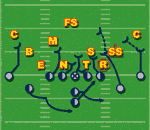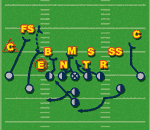|
AFM Home | Sample Articles | Triple Option Means Triple Threat Clinic By Scott Wachenheim
He started toying with the concept while coaching at Ingleside and Breckenridge High Schools. Coach Bellard felt to be successful on offense, one needed to: • Have a blocker on a defender with a ball carrier behind. • Have two blockers on one defender with an option play. • Create one-on-one match-ups in the passing game. Coach Bellard was hired to coach linebackers at the University of Texas in 1967. In the spring of 1968, Texas head coach Darryl Royal moved Emory from coaching linebackers to the offensive side of the ball. Coach Royal was always a fan of the option offense. In looking at the personnel Texas had, Coach Bellard felt they had three great running backs. So he put in the basic-T formation and began running the triple option. That summer Coach Bellard, his sons, and some former Texas players ran through the option from a variety of sets and came upon the wishbone. Coach Bellard did not call his formations the wishbone. He simply called the formations right and left. The originator of the wishbone nickname was the Mickey Herskowitz of the Houston Chronicle. Coach Bellard presented his findings to Coach Royal, who embraced the idea. Texas tied their first game, lost their second, then won thirty straight games and two national championships in the wishbone. Coach Hatfield, HC, Rice University, first fell in love with the wishbone triple option attack while coaching defense at the University of Florida. He realized the difficulties of the defending against the option and the one-on-one passing attack, therefore when he was moved to coach offense he quickly initiated the triple option attack at Florida. The wishbone has helped Coach Hatfield become fifth in wins among active Division 1-A head coaches. While at the United States Air Force Academy, Coach Hatfield began to tinker with the offensive sets. He began to break the bone, putting one or both of the halfbacks in a slot position. The new formations were given the nickname of the “Flexbone” and we are still using them today at Rice University.
In double slot formation our offensive linemen line up as close to ball as legally allowed. They align such that their helmets are on a parallel line originating from the armpit of the center. There are two reasons for this alignment. First, we believe it helps us stop defensive penetration. Secondly, we believe it allows us to get past the read key quicker, therefore making the quarterbacks triple option read easier. Our base splits for our guards are three feet, while our tackles can vary their splits from three to five feet. Our offensive line must understand they are blocking for the fullback carrying the football. This places a premium on creating movement off the ball, however decreases the amount of time they must sustain their blocks. Our quarterbacks line up directly behind the center in a balanced stance to give them the ability to run the play either direction. The quarterback must first locate the read key. The read key is the defender responsible for the fullback. He is usually the first defender lined up on or outside the play side tackle. The quarterback after receiving the snap will pivot to 3 or 9 o’clock to establish his mesh with the fullback. If the read key is up field to take the quarterback, the quarterback will give the ball to the fullback. If the read key squeezes down to take the fullback, the quarterback will disconnect from the mesh and locate the pitch key. The pitch key is usually the first defender lined up outside the read key. Once the quarterback locates the pitch key, he must determine whether the pitch key has the quarterback or the pitch back. If the quarterback decides to keep the ball he will plant off his outside foot and attack downfield. If the quarterback determines to pitch the ball he will execute a basketball pitch to the slot back. We see two advantages to using the basketball pitch instead of the thumb-under pitch. First, a basketball pitch can be lofted higher and is softer, making it easier to catch and more accurate. Secondly, a basketball pitch can be executed from a variety of different positions, giving us the ability to pitch the ball versus several different situations created by the defense. For example, versus a strong safety blitz the quarterback could pitch the ball high or low depending upon the angle of the strong safety. Our fullbacks line up with their feet four-to-five yards from the football, which should correspond with their down hand being four-to-five feet behind the quarterback’s heels. The slower the fullback, the closer he lines up and, conversely, the faster the fullback, the farther he lines up. Our fullbacks also line up in a balanced stance to give them the ability to run in either direction. The fullback’s aim point for the mesh is the crack of the play side guard’s rear end. If the fullback gets the ball, he will square his shoulders to the line of scrimmage and run off the blocks of the play side guard and tackle. If the ball is disconnected from the mesh by the quarterback, the fullback will still square his shoulders to the line of scrimmage in order to absorb the blow delivered by the read key. The mesh between the fullback and the quarterback is critical to the success of the triple option. We spend a lot of time perfecting this phase in practice. The quarterbacks and fullbacks will work on this together for five to ten minutes a practice. We will then add a read key to the drill. Next we will go to a half-line drill versus a scout defense. Finally, we will scrimmage against our own defense to gain an understanding of the speed at which the decisions must be made in this phase of the option. Our slot backs line up one yard outside and one yard deeper than our offensive tackles. The slot back opposite the play will go in two-step motion prior to the snap in order to attain a four-yard outside by two-yard behind pitch relationship with the quarterback. The play side slot back has a critical point of attack block. He is blocking for the quarterback carrying the football. The play side slot back must be able to block a tight scraping line backer and a line backer that is trying to beat him over the top. He does this by taking a tight path through the outside hip of the read key to cut off the tight scrape, keeping his eyes on the linebacker to adjust to the wide scrape. We would like for our play side slot to cut block the linebacker. However, if the play side tackle is engaged with the linebacker the slot must block the linebacker high to avoid a chop block penalty. The play side slot must also be able to see when the play side tackle has blocked the play side linebacker. When this scenario happens our play side slot will work up field to block the free safety. Our wide receivers base splits are: Boundary: Bottom of the numbers. Field: Two yards outside the hash. Middle: Top of the numbers. Our play side receiver is responsible for blocking the first support from the defensive secondary. To accomplish this, they must first know who will be the pitch key. It is critical for the quarterback and the receiver to be on the same page. After identifying the pitch key, the play side receiver will read where secondary support is coming from. If the receiver determines he must crack block the safety, he must know he is blocking for the quarterback. If the receiver determines he must stalk block the corner, he must understand he is blocking for the pitch back. The following are our rules and options for executing our base triple option attack: FST Veer - B gap to FSLB to BSLB to FS. 4 - Stack vs. Stack. 3Tech - Double, Fold, or Base by game plan. FSG - 1 LOS. 3Tech - Double, Fold or Base by game plan. Shade/1Tech - Slip. C - Front side A gap. Slip/Scoop. BSG - Scoop. BST - Scoop. WR - Play side: Block first support. Back side - Cut off deep third defender. Play side back - Block play side LB to FS. Back side back - Attain pitch relationship with QB. FB - Mesh with QB at crack of guard’s rear end. QB - Read first down lineman from a 4 technique out, pitch off next outside defender. (See Diagrams 2-5) The triple option offense holds a unique place in college football history. We hope this article helps you better understand it’s beginnings and how it is still helping teams win today.
|




